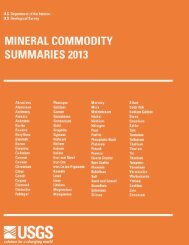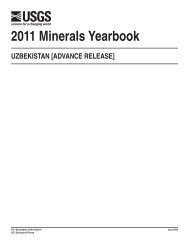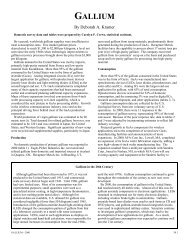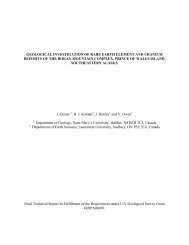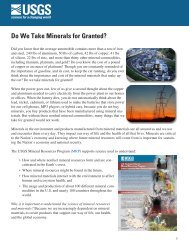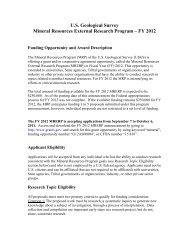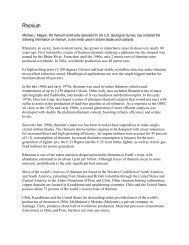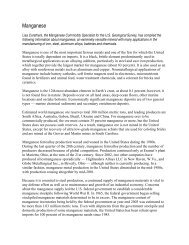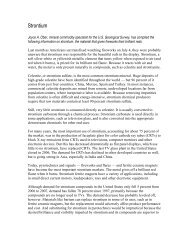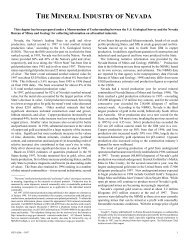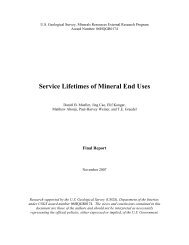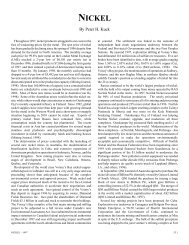Mineral Commodity Summaries 2003 - Mineral Resources Program ...
Mineral Commodity Summaries 2003 - Mineral Resources Program ...
Mineral Commodity Summaries 2003 - Mineral Resources Program ...
You also want an ePaper? Increase the reach of your titles
YUMPU automatically turns print PDFs into web optimized ePapers that Google loves.
TITANIUM MINERAL CONCENTRATES<br />
Events, Trends, and Issues: Owing to a slowing world economy, global consumption of titanium concentrates was<br />
estimated to have decreased moderately in 2002 compared with that of 2001. Increased production of titanium<br />
dioxide pigment resulted in an estimated 4% increase in domestic consumption of titanium mineral concentrates<br />
compared with that of 2000. The United States continued its reliance on imported mineral concentrates primarily from<br />
Australia, Canada, and South Africa. In 2002, imports of titanium concentrates increased an estimated 7% compared<br />
with those of 2001.<br />
In 2002, numerous projects were underway to develop new sources of titanium mineral concentrates. In the United<br />
States, feasibility studies were being conducted at the Camden, TN, and Limon, CO, deposits. In Canada, a bulk<br />
sampling program was in progress at Truro, Nova Scotia. The first phase of a bankable feasibility study was<br />
completed at the Corridor Sands project in Mozambique. If completed, Corridor Sands would produce 1 million tons<br />
per year of titanium slag. In Australia, a host of projects primarily located in the Murray Basin were in various stages of<br />
development. Mine construction was expected to begin on the Moma project in Mozambique. If completed, the Moma<br />
project would produce 625,000 tons per year of ilmenite and 12,500 tons per year of rutile.<br />
World Mine Production, Reserves, and Reserve Base:<br />
Mine production Reserves 5<br />
Reserve base 5<br />
2001 2002 e<br />
Ilmenite:<br />
United States 2 6 300<br />
6<br />
300 7,000 59,000<br />
Australia 1,150 1,100<br />
7<br />
200,000<br />
7<br />
250,000<br />
Canada 8<br />
950 950 31,000 36,000<br />
India 232 250 30,000 38,000<br />
Norway 8<br />
338 350 40,000 40,000<br />
South Africa 8<br />
960 950 63,000 220,000<br />
Ukraine 252 250 5,900 13,000<br />
Other countries 391 390 49,000 84,000<br />
World total (ilmenite, may be rounded) 4,600 4,500 420,000 730,000<br />
Rutile:<br />
United States ( 9 ) ( 9 ) 400 1,800<br />
Australia 225 220<br />
7<br />
22,000<br />
7<br />
34,000<br />
India 16 15 6,600 7,700<br />
South Africa 110 105 8,300 24,000<br />
Ukraine 56 56 2,500 2,500<br />
Other countries 4 4 8,000 17,000<br />
World total (rutile, rounded)<br />
10<br />
410<br />
10<br />
400 48,000 87,000<br />
World total (ilmenite and rutile, rounded) 5,000 4,900 470,000 820,000<br />
World <strong>Resources</strong>: Ilmenite supplies about 90% of the world’s demand for titanium minerals. World ilmenite<br />
resources total about 1 billion tons of titanium dioxide. Identified world resources of rutile (including anatase) total<br />
about 230 million tons of contained TiO 2.<br />
Substitutes: Ilmenite, leucoxene, rutile, slag, and synthetic rutile compete as feedstock sources for producing TiO 2<br />
pigment, titanium metal, and welding rod coatings. In the future, commercial processes may be developed to use<br />
anatase and perovskite.<br />
e<br />
Estimated.<br />
1<br />
See also Titanium and Titanium Dioxide.<br />
2<br />
Production rounded to one significant digit to avoid disclosing company proprietary data.<br />
3<br />
Excludes ilmenite used to produce synthetic rutile.<br />
4<br />
Defined as imports - exports + adjustments for Government and industry stock changes.<br />
5<br />
See Appendix C for definitions.<br />
6<br />
Includes rutile to avoid disclosing company proprietary data.<br />
7<br />
Derived from data published by the Australian Geological Survey Organisation.<br />
8<br />
Mine production is primarily used to produce titaniferous slag. Reserves and reserve base are ilmenite.<br />
9 Included with ilmenite to avoid disclosing company proprietary data.<br />
10 Excludes U.S. production.<br />
179<br />
U.S. Geological Survey, <strong>Mineral</strong> <strong>Commodity</strong> <strong>Summaries</strong>, January <strong>2003</strong>



